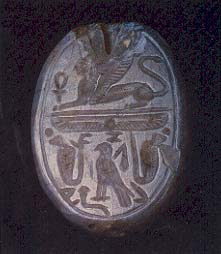Image Details

Zev Radovan, courtesy Ephraim Stern
The seal of Jezebel. This recently discovered seal may well have belonged to Jezebel, the wife of King Ahab of Israel (874–853 B.C.E.) and the daughter of Ethba’al, king of Sidon, a major Phoenician city. The Bible condemns Jezebel for promoting worship of the Phoenician god Baal (1 Kings 17 and 18).
Carved in the Phoenician style, the seal incorporates such Egyptian elements as the ankh, at upper left, and the winged disk, across the center. Four mirror-image paleo-Hebrew letters, two just below the winged disk and two at lower left and right, spell out yzbl, Jezebel. They are written in mirror-image form so as to read correctly when the seal is impressed in wet clay.
